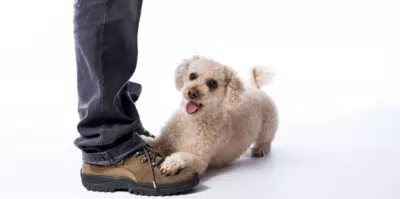Separation Anxiety in dogs
- 19 Aug 2020
- 7m read

By Penaran Higgs, Clinical Animal Behaviourist
Dogs, like us, are very social animals having evolved alongside us over thousands of years, so dogs should never be left for too long on their own (4 hours is plenty). If they learn get used to being left for short periods as pups, they are far more likely to grow up feeling relaxed and comfortable when left on their own as adult dogs.
There are many different reasons why a dog shows problematic behaviour when left alone. Just because a dog destroys your furniture, don’t assume they have separation anxiety. Instead, there may be medical issues, barrier issues, toilet training issues, boredom, or noise/environmental phobias.
Often setting up a camera will reveal the cause. It is also crucial to see your vet – even if you don’t think there is a medical cause.
Is it Separation Anxiety or something else?
Medical: If a dog is unwell, then they may show problem behaviour when left alone. Perhaps as they feel physically worse when they are left alone due to a lack of distraction, or with the owner not being there for them.
Barrier issues/ frustration: This occurs when a dog is confined or restricted, and wants to get out to join in with activities they can see or hear – whether it be their owners or noises outside in the street. Not being able to get to what they want causes them to become frustrated. It can be mistaken for separation anxiety if it regularly happens when the owner is not at home, but tends to occur when the owner is home too.
Incomplete toilet training: Some owners believe because a dog can hold it for 10 hours at night, they should be able to do this during the day too. Their diurnal rhythm often has other ideas. And once a dog has toileted in a particular place, they often feel tempted to repeat this.
Boredom: Dogs can simply get bored and destroy a home when left alone, especially young, active dogs with a strong working drive.
Separation Anxiety
This is commonly found when pups have had a bad start in life or have developed the wrong bond with their owners. It is common in certain smaller breeds who are bred to be companion animals. It can be also be triggered if people get a pup and then go away on holiday soon after. Sometimes people simply never teach the dog how to be alone, or a dog’s previous companion dog passes away. Another risk factor is when the pup has been taken away from the mother at 9-10 weeks rather than 8 weeks. These can all trigger separation issues.
When the puppy is taken away from their mother and littermates, there is a great disruption in the existing maternal bond, which must be transferred onto the new owner for the puppy to feel safe and secure. It is crucial that the new owner is able to make time to forge a correct bond with the puppy.
Separation anxiety symptoms. Does my dog have an issue?
Your may have a separation issue if your pup or dog becomes distressed as soon as you leave. You may notice panting, salivating, restlessness, sweaty paw-prints on the floor, toileting or anxious behaviours such as feet chewing. Your dog may try to follow you as you leave, scratching at doors, chewing at door/window-frames to try to follow you. They may bark, whine or howl, often starting at a low level whimpering and then getting louder. Often you will then hear a pause as they wait to see if anyone is coming back for them.
On your return, your dog may become very excitable. They may be wet, either from salivating or excessively drinking due to stress. They may follow you from room to room and show anxiety when you prepare to leave.
How to ensure your pup never develops issues with separation, and how to help a dog who has.
For the first few weeks, keep your new puppy as close to you as possible, eg in a box near your bed. Comfort them when they are distressed. Puppies who are left alone at night early on are far more likely to develop separation issues in the future.
If your dog already has an issue, never leave them alone. Instead, enlist family, friends, dog walkers or doggy daycare to help.
Stair gates (not crates) can be used to help dogs get used to being left alone whilst you’re still in the house. They aren’t as scary as a closed door as they still allow your dog to see, smell and hear you. Make sure they are left in a comfortable safe place where they cannot hurt themselves, away from windows where noises could set them off. It should somewhere they tend to relax in – and not feel socially isolated (e.g. not the utility or spare room). Put a comfortable bed and water in this area, and safe chew items, should your dog need them (chewing is a calming activity). Some dogs find a t-shirt that smells of their owner reassuring. Randomly during the day, pop your dog behind the stair gate with a tasty chew, eg a Kong toy stuffed with treats or frozen Butternut Box food. Close the stair gate behind you and go about your business as normal, but try to stay in eye and earshot of your dog.
If you find that your dog struggles with this in any way, stay quietly in the room with them, without interacting. Once they can manage this, you can start leaving them again for a few minutes. After a few days, gradually increase the time your dog is left behind the stair gate until you get to a point that they feel relaxed enough for you wander out of sight completely. Once your dog is comfortable with this, you can begin to get them used to short periods of time alone in the house. Start with 1 minute or less and gradually increase this. Some dogs will find this hard. If you find your dog begins to look worried when you pick up your keys or put on your coat to go out, you can start desensitising them to these cues: put your dog in the area during the day as before and get them used to you picking up your keys, coat or bag but not going out, instead, sit down and do something else. Once they are calm with this, you can start actually leaving them for short periods.
Keep greetings on your return friendly, low-key and predictable but DO acknowledge them. Ditto leavings – say goodbye but don’t go over the top with your good-byes! Dogs are sensitive to changes in their environment and the transition from the sights and sounds of when you are present to silence in the home when you leave is profound. Leaving lights on and playing music can help make the transition easier. It is even better if the noise is something that you tend to have on when you are in the house - the same radio or TV channel or even recorded sounds of the family. Never punish. This always makes things worse.
Make sure your dog has enough exercise before leaving them – it is a potent anxiety reliever.
Teach them impulse control exercises such as waiting before going through a door or waiting before you give them their food. Another suggestion is making sure that the games you play with them have rules that you are in charge of.
If your dog has destroyed or toileted in our house on your return, never punish. Punishment will make things worse, because as well as being anxious about being left, they will also be worried about you returning.
Don’t be tempted to get another dog - it may create more problems than it fixes, especially if the new dog comes with issues or there is not a good relationship between then two. Sometimes owners end up with two dogs with separation anxiety as the new dog learns from the existing one that being alone is scary.
Separation anxiety and food
Many dogs with true separation anxiety don’t tend to eat when they are left alone. Others, enjoy food as a distraction. A diet with lots of artificial preservatives and colourants, or the wrong type of food for a particular breed can also lead to over aroused and frustrated behaviour.
Our advice
If your dog has an established separation problem, then it’s best to seek professional help. All cases are different so it’s impossible to develop a one size fits all approach. The Association of Pet Behaviour Counsellor will help you to find a reputable behaviourist or trainer local to you.




.png)